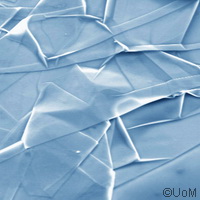Graphene and a new dimension
A growing number of scientists recognises how graphene, an allotrope of carbon, is the next silicon. But they also know graphene is too conductive to be used in computer chips. Now a research team from the University of Manchester in the United Kingdom may have found a way to address this problem. Presented in the journal Science, the study demonstrates how a transistor could indeed be the missing link for graphene to become the next silicon. Their discovery opens a third dimension in graphene research. The Manchester group, led by Nobel laureate professors Andre Geim and Konstantin Novoselov, both of whom were knighted earlier this year, notes how graphene is a fascinating material with myriad properties, namely optical, mechanical, electronic and chemical. Experts say graphene can be used to form the basis of computer chips, overtaking silicon as the material of choice. Companies all over the world, such as Samsung, Intel and IBM, have already expressed an interest in graphene. Single transistors with very high frequencies (up to 300 GHz) have already been demonstrated by a number of groups around the world. The problem with these transistors, however, is that they cannot be packed densely in a computer chip because they 'leak' too much current, even in the most insulating state of graphene. This electric current quickly leads to the melting of the chip. Despite the various studies performed to solve this problem in the last eight years, no solid solution has ever emerged. But the Manchester team may have found the missing piece to this puzzle. According to the researchers, graphene should be used in the vertical instead of the lateral direction (in plane). The team used graphene as an electrode from which electrons tunnelled through a dielectric into another metal. The researchers call this a tunnelling diode. They focused primarily on a unique feature of graphene: how an external voltage can strongly change the energy of tunnelling electrons. What they got was a new type of a device, that is, a vertical field-effect tunnelling transistor where graphene is the key ingredient. 'We have proved a conceptually new approach to graphene electronics,' says the senior author of the study, Dr Leonid Ponomarenko of the University of Manchester's School of Physics and Astronomy. 'Our transistors already work pretty well. I believe they can be improved much further, scaled down to nanometre sizes and work at sub-THz frequencies.' For his part, Professor Novoselov says: 'It is a new vista for graphene research and chances for graphene-based electronics never looked better than they are now.' But graphene cannot work alone; other materials were needed as well. The Manchester group combined graphene and atomic planes boron nitride and molybdenum disulfide to develop the transistors. These transistors were made layer by layer in a desired sequence, on an atomic scale. These types of 'layer-cake' superstructures do not exist in nature, the researchers say. This innovative concept offers new degrees of functionality, with the tunnelling transistor being a vital component. 'The demonstrated transistor is important but the concept of atomic layer assembly is probably even more important,' says Professor Geim. Adds Professor Novoselov: 'Tunnelling transistor is just one example of the inexhaustible collection of layered structures and novel devices which can now be created by such assembly. It really offers endless opportunities both for fundamental physics and for applications. Other possible examples include light emission diodes, photovoltaic devices, and so on.'For more information, please visit:University of Manchester:http://www.manchester.ac.uk/Science:http://www.sciencemag.org/
Countries
United Kingdom



